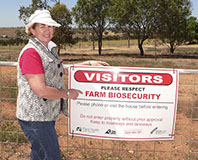Read the latest information on
Foot-and-mouth disease
 A new approach to managing biosecurity is underway with new biosecurity acts for NSW and Queensland, placing greater responsibility on producers and reducing government regulation.
A new approach to managing biosecurity is underway with new biosecurity acts for NSW and Queensland, placing greater responsibility on producers and reducing government regulation.
Queensland implemented its Biosecurity Act 2014 on 1 July, and NSW is expected to officially implement its new legislation next year.
Queensland’s Chief Veterinary Officer Alison Crook explained what the changes mean to producers.
“Under the Queensland act, individuals and organisations whose activities pose a biosecurity risk have greater legal responsibility for managing them. This general biosecurity obligation means they must take all reasonable steps to ensure they do not spread a pest, disease or contaminant,” Dr Crook said.
The new act for Queensland will, as Dr Crook highlighted, allow for greater flexibility with flow on effects for all livestock industries.
“Frontline staff now have more flexibility in working with the community, allowing them to deliver better services with less disruption and cost to the community.”
“The act also accommodates industry initiatives. For example, the act allows for compliance agreements and industry accreditation schemes, which utilise industry knowledge about best practice risk management for their unique circumstances,” Dr Crook said.
Whilst not yet implemented, the Biosecurity Act 2015 for NSW will bring together 14 separate acts under a ‘shared responsibility’ and ‘general biosecurity duty’ approach, meaning everyone will play a role.
NSW will also look to industry to help manage risks by establishing biosecurity certification and auditing schemes and will rely on the general community as a source of information as they are the ‘eyes and ears’ at the grass roots level.
With a greater emphasis on shared responsibility, producers should begin developing their own biosecurity plan through the Farm Biosecurity website. To develop a customised plan go to the biosecurity Profile page and create your own kit. Alternatively, a range of biosecurity manuals for various livestock industries and the Farm Biosecurity Action Planner are available to download at no cost.
The improvement to biosecurity management and the flow-on benefits to producers from the introduction of the NSW and QLD acts will be further enhanced with the recent introduction of the Australian Government’s Biosecurity Act 2015, said Duncan Rowland, Animal Health Australia’s Executive Manager, Biosecurity Services.
“The Australian Government’s new biosecurity legislation, introduced on 16 June, replaces the 108 year-old Quarantine Act 1908. This new legislation will help protect our livestock industry by providing a much more modern, clear and flexible framework for managing biosecurity risks from imports and exports and the infrastructure that supports the movement of goods into and out of the country,” Mr Rowland said.
Producers are also encouraged to visit the relevant NSW and Queensland government websites to learn more about how the new acts will affect them.
There’s changes happening for ACT producers as well!
The ACT is home to approximately 78,000 sheep, 12,000 cattle, 1,500 horses and 200,000 chickens, which means biosecurity is just as important to this little territory as well.
The ACT Government recently launched the ACT Biosecurity Strategy 2016-26, which also calls for shared responsibility between government, industry and the community. All producers who graze or undertake poultry production in the ACT should familiarise themselves with this important document.